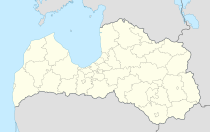Līgatne
| Līgatne sds | ||
|---|---|---|
 |
|
|
| Basic data | ||
| State : |
|
|
| Landscape: | Livonia ( Latvian : Vidzeme ) | |
| Administrative district : | Līgatnes novads | |
| Coordinates : | 57 ° 14 ' N , 25 ° 3' E | |
| Residents : | 1,147 | |
| Area : | 7.4 km² | |
| Population density : | 155 inhabitants per km² | |
| Height : | 88 m | |
| Website: | www.ligatne.lv | |
| Post Code: | ||
| ISO code: | ||
Līgatne , since 2009 Līgatnes novads , (German Ligat ) is a small town in northern Latvia on the banks of the Gauja in the Gauja National Park . In 2009 the city and its rural community united to form Līgatnes novads . In 2016 Līgatne had 1147 inhabitants.
history
The village developed around a paper mill , which was founded in 1815 by Justus Storch. In 1864 the AG Rigaer Papierfabriken bought the Ligat paper mill. Towards the end of the 19th century, workers' settlements, a hospital, a cultural center, a kindergarten and other facilities were built around the factory. In a social model that was unique at the time, workers were granted free housing, heating, electricity, child-rearing, pension, etc.
An upper district developed on the Riga-Pleskau road . Tourist attractions today are a nature park with outdoor enclosures for native wild animals, a Soviet bunker built for the government of the LSSR, the former factory, a wooden car ferry across the Gauja and the Gūdu rocks .
History of the paper mill
The village is closely connected to the paper mill located there.
A contemporary witness report describes the worker benefits at the beginning of the 20th century:
“The Ligat workers earned ... cash wages for the 12-hour work that was common at the time, about as much as was paid in industry in the Riga district. But they enjoyed a lot of perks that were missing in the city: free housing and heating, with firewood available to them as much as they needed. Then: free medical treatment and medication. There were no state health insurances at the time, so there were no deductions from wages. In Ligat there was a hospital with 8 beds, […] there was also a very well equipped […] very well looked after maternity hospital. Old Dr. Vogel, who lived about 5 km from Ligat, came regularly to the factory twice a week, and the healing assistant lived there [...] Furthermore, the people had free school for all children, for example in the elementary school. All school material is free. The school was divided into 3 classes, the lessons were given by 3 teachers, [...] Whether and in what amount a wage tax was levied is not available to me. I do not think so; because there was no income tax back then. "
Paper production in Līgatne was stopped during the First World War , the paper machines were dismantled and brought to Russia.
In 1920, the new government of the Republic of Latvia provided 20 million Latvian rubles to rebuild the factory and restart paper production. In the 1920s and 1930s, the Līgatne paper mill had the most modern paper production facilities in Europe and was one of the best fine and specialty paper mills.
Production was stopped again during the Second World War and resumed on 3 paper machines in February 1945.
During a fire in 1993, the factory partially burned down and was rebuilt through donations. In 2000 it was founded under the name SIA "PAPĪRFABRIKA LĪGATNE" Ltd. registered as a GmbH. In 2014 bankruptcy had to be filed.
people
- Asja Lācis (1891–1979), actress, director and theater manager
See also
literature
- Hans Feldmann , Heinz von zur Mühlen (Hrsg.): Baltic historical local dictionary, part 2: Latvia (southern Livland and Courland). Böhlau, Cologne 1990, ISBN 3-412-06889-6 , pp. 350–351.
- Astrīda Iltnere (ed.): Latvijas Pagasti, Enciklopēdija. Preses Nams, Riga 2002, ISBN 9984-00-436-8 .
Individual evidence
- ↑ Latvijas iedzīvotāju skaits pašvaldībās pagastu dalījumā
- ↑ Hans Feldmann, Heinz von zur Mühlen (ed.): Baltic historical local dictionary, part 2: Latvia (southern Livland and Courland). Böhlau, Cologne 1990, p. 350.
- ^ Robert Burmeister: The paper mill. Joern Burmeister, accessed on June 10, 2018 .
- ↑ W. v. Schilling: Memories of the Ligat paper mill , manuscript 1956.
- ↑ Pasludināts "Papīrfabrikas Līgatne" maksātnespējas process. August 7, 2015, accessed August 7, 2015 .

